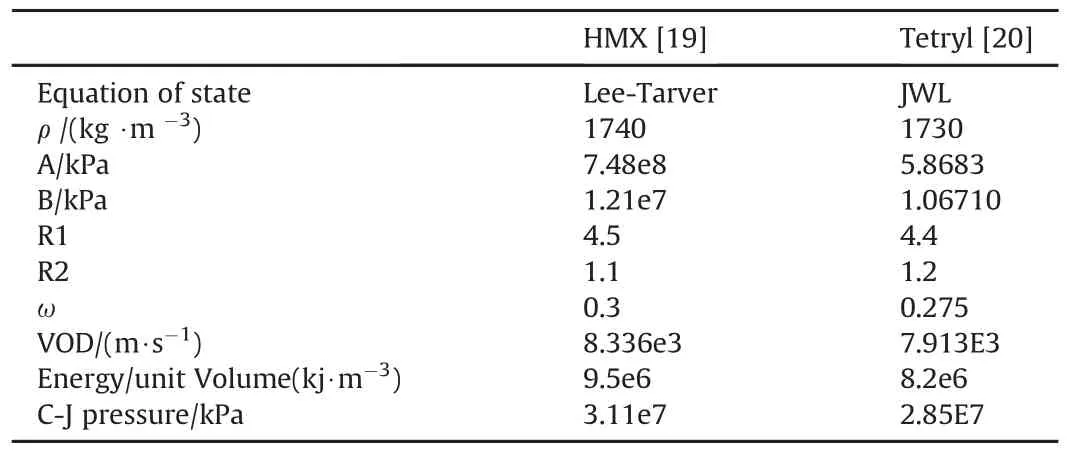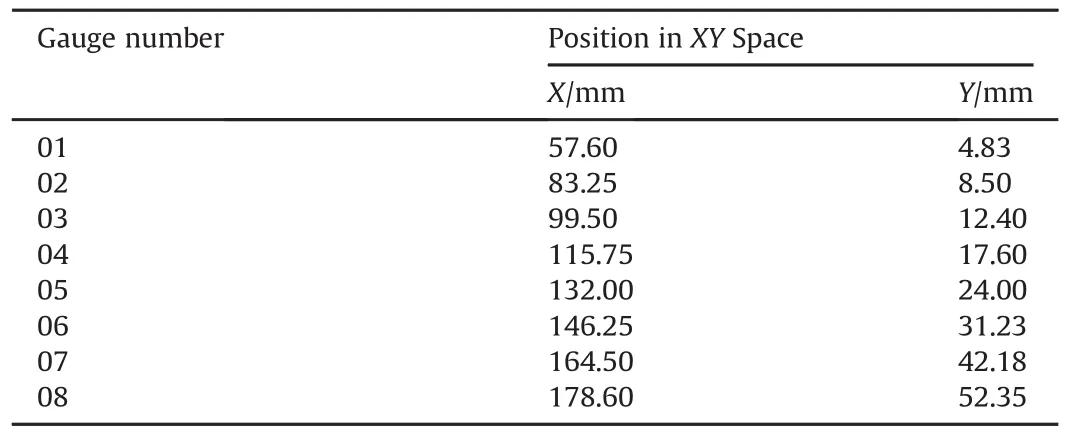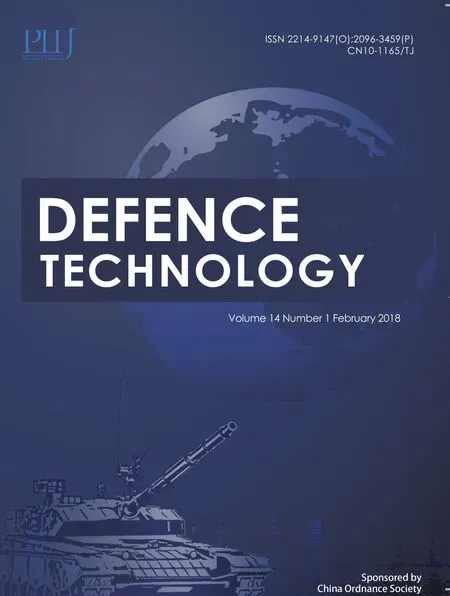Numerical and experimental study of wave shaper effects on detonation wave front
2018-03-12KhalidNaeemArshadHussain
Khalid Naeem,Arshad Hussain
aSCME(NUST)Islamabad,Simulation Lab.Room 113 SCME NUST H-12 Campus,Islamabad,Pakistan
bSCME(NUST),H-12 Campus,Islamabad,Pakistan
1.Introduction
Shock wave is a small region moving at supersonic speed,where there is a sharp rise in density,pressure and temperature[1].Shock region is further divided into two regions shocked zone and the chemical reaction zone[2].Shock waves are maneuvered in required direction with the help of wave shaper which consists of either energetic or inert material[3].This technique is called wave shaping.Perspex is normally used as an inert material for wave shaping[4].Wave shaper is incorporated in shaped charges to enhance its penetration effect[5].
A shaped charge is a device made by shaping the explosive in such a way to direct its energy to a specific location.Location may be a line or axis in case of linear shaped charges and conical shaped charges respectively.Major components of shaped charge are a Metallic liner,Explosive or Main Charge,Initiating assembly and Casing.Conical shaped charges are utilized against tanks,armour and bunkers while linear for demolition purposes.The behavior of shock front within the explosive of conical shaped charge will be studied in current research.
Perspex cone was used as a shutter for the streak cameras.Perspex is a transparent material at normal pressure and temperature but,when shock wave passes through perspex,it behaves opaque[6].This property is utilized to use perspex as a shutter.Streak Camera is a tool for studying variations in light intensity as a function of time[7].Perspex is utilized to find shock profile along an explosive specimen[8]and for finding detonation velocity of infinitely large charge diameter(D∞)[9].Moreover,it is utilized in multi streak techniques[10].During the current study,a three dimensional solid perspex mask in the shape of the cone is used to compare streak results obtained with wave shaper and without wave shaper.These streaks also give information about the centricity of assembly and detonation wave symmetry along the whole length of the mask.Alternate of masking technique is the fiber optic probes installed at specified location but when the number of probes is increased;it will disturb the wave front propagation[11].Therefore,streak camera technique was utilized in this study because it is a better option than fiber optic probes.The three-dimensional mask made of perspex is in the shape of a solid cone whose outer shape fits inside the explosive.The mask was painted black on the exterior surface except for the grooves to capture streaks.The base of the perspex cone was polished;to make it more transparent.When the shock front enters the grooves of the perspex cone,air molecules within the grooves are excited and on de-excitation,they emit intense light which comes through the perspex and recorded by the streak camera[12].After passing the air gap when shock front enters the perspex,it becomes opaque so no light is recorded on streaks,otherwise light will sweep over the entire film.
Aim of the research work is to carry out investigation of the shock front at the interface of liner and the explosive as to the best of my knowledge this area has not been explored previously.This research work will give information of the shock front velocity at the interface.The research may further be extended by using the fiber optic probes simultaneously with the perspex mask for time measurement.Use of pressure gauges if possible would further illuminate the research.
2.Materials and methods
2.1.Explosive cone manufacturing
Explosive cone was manufactured by turning as a single unit for the experiment without wave shaper.In order to avoid any mishap,sufficient coolant was continuously provided during machining and cut size was kept to a minimum.Allowable tolerance was+50 and-50μm according to requirements.For the experiment with wave shaper,the explosive cone was manufactured in two parts to accommodate wave shaper within it.The diameter of the cone was 115.525±0.050 mm and its length was 117.578±0.050 mm.
2.2.Mask manufacturing

2.3.Aluminium parts
Casing,back part and front rings were manufactured from Aluminium alloy dural by turning mechanism.Dural contains 4%copper and small amounts of magnesium,manganese,iron,and silicon.Apart from turning,milling was also performed for the four cuts on the front ring and back part.Photograph of individual parts before assembly is given in Fig.2.Exploded view of the assembly made by computer aided design(CAD)software Pro Engineer is given in Fig.3.
The CNC milling and turning were employed because it reduces cost of manufacturing and lead times,improves quality of the products and increase productivity.These machines are operated with cent percent control over velocity and positioning.By introducing small cut the part can be made with very tight tolerance as per requirement of the assembly.They operate faster than the conventional machines.These can be operated 24 h a day and seven days a week by providing a proper operating temperature.As these are operated through computers,the chance of a human error is nil.Advanced software allows CNC machines to make products that cannot be made by hand,even by the most skilled machinists available.
2.4.Experimental setup
Experiment was performed in blast chamber.Rotating mirror camera(RMC)and image convert or camera(IMACON)were used for recording.The event was observed by cameras through a blast proof window.Both the cameras and detonation were triggered by a single electronic delay unit.Delay unit initiated cameras after detonation with a delay of 10 and 12 micro seconds for experiment without and with wave shaper consecutively.
2.5.Simulation
Explicit dynamic analysis code Ansys Autodyn®was used to run the simulation.It contains three solvers Lagrangian,Eulerian and ALE.ALE solver has the edge over Lagrangian and Eulerian that mesh geometry is organized without material geometry[13].Lagrangian solver produces errors in results for the simulation of jet formation because mesh highly distorts with time[14].In order to save computational time,2-D axial-symmetry for both the problems was adopted.The mesh used a regular cell with a size of 0.33 mm×0.33 mm/cell for the whole computational domain.The utilized equation of states and material properties are given in Table 1 and Table 2.Jones-Wilkins-Lee(JWL)equation of state used for Tetryl in both solid unreacted and gaseous reacted phase is governed by Ref.[15].
where p,V and E in the equation represents the detonation pressure,relative volume and the internal energy per unit volume of the explosive respectively and the rest are the constants.
Lee-Tarver ignition and growth model was used for the main charge.It is based on hot spot theory which suggests that initially local hot spots are created and then ignition grows from these hot spots[16].Governing equation is
WhereF,ρ0,ρ andpare the reaction ratio,initial density,current densities and pressure respectively.Co-ordinates of the gauge points are tabulated in Table 3.Boundary condition was set to“Flow Out(Euler)”which represent materials once passed out of the grid will never contribute to any process.Shock arrival time of simulation in both cases are tabulated in Table 4 which shows that shock front arrives late in the presence of wave shaper due to shock turning.This turning can be seen in Fig.8.

Table 1Properties of energetic materials.

Table 2Properties of materials.

Table 3Gauge coordinates.
3.Results and discussion
Shock front arrival times for experiment without and with wave shaper were calculated from Figs.4 and 5 respectively.Resultant streaks were printed on 1:1 ratio and distances between adjoining streaks were measured within±0.5 mm.From safety point of view an oblique viewing angle was set for the cameras to capture streaks which resulted in elliptical streaks.To get circular streaks camera and the event must be in one line which was not affordable.Fig.5 show that width of the streaks along the entire circumference of each circle is uniform;this uniformity suggests that there is no susceptible porosity or crack within the high explosive.Rotation speed of the film in both experiments was set to 9 mm/μs.To find average velocity between two consecutive grooves only two parameters time and distance are required.For the experiment without wave shaper,time was measured from streaks lengths which in turn were calculated from Fig.4 by dividing streak length with camera speed while the distances between adjoining grooves were measured from the manufacturing drawing of the perspex mask.Streak length,corresponding times and velocities for experiment without wave shaper are given in Table 5 Comparison of experimental and simulation velocities having no wave shaper is plotted in Fig.6 which depicts that experimental velocities arelower than simulation at each point and as the time passes the detonation velocity increases.For the experiment with wave shaper,times required for velocity calculations were measured from the streak distances between the two consecutive circles using Fig.5 and the data are tabulated in Table 6.Comparison of experimental and simulation velocities is plotted in Fig.7 which shows the same increasing velocity trend as time passes and higher velocities were observed for simulation as in the previous case.The expected increasing velocity trend obtained in experiments and simulations is due to the shape of the cone.As shape of the cone is trumpet,so the wave front has to move along the trumpet surface of the perspex and not in straight line thus arriving quickly.Moreover simulation velocities are higher than corresponding experimental velocities due to following reasons which we took for granted.

Table 4Simulation shock arrival time(μs).
a)The density of the explosive is uniform throughout.
b)The velocity of detonation is uniform along the entire length of explosive.
c)Detonation point is perfectly at the centre of the assembly.
d)Booster explosive is enough to detonate the main charge symmetrically.

Table 5Times for experiment without wave shaper.

Table 6Times for experiment with wave shaper.
Although there are always some minute variations in density when the explosive is pressed which are unavoidable.The velocity of detonation is not uniform and it takes some distance knows as run to detonation distance to reach its maximum velocity[17].Detonator placement may vary although in sub millimetres,making it off centred which affects the process[18].Last but not least the booster may not be able to initiate the high explosive along its contact.Figs.6 and 7 show that detonation velocities for HMX are different for the two-setup mentioned earlier although both parts were manufactured from the same pad,having same density.This is justified by the corner turning of shock front around the wave shaper as shown in Fig.8.The same increasing velocity trend was observed for both the simulations and experiments.
4.Conclusions
Experiments were successfully performed to observe the shock front,arriving along the entire length of the perspex mask.The assembly was perfectly symmetric for the entire time starting from detonation till the shock front reaches the base of the explosive cone.This fact was established by the concentricity of the circles.Uniformity of the streaks thickness along the circumference shows that there is no perceptible porosity.Top attack of the shock front during simulation was observed in case of wave shaper as shown in Fig.8 which was verified by the late arrival of the shock front in the experiment.The top attack allows more material of the liner to flow into the jet producing a uniform and less perturbed jet.Shock front velocities calculated from both experiments do not match with those available in the literature.The reasons are(a).For exact velocity calculations cylindrical explosive of required diameter and length is required and(b).The arrival time of the shock must be measured in a straight line.These conditions were not satisfied in both the experiments because the cone is having a variable diameter as we move from apex to the base and the timing probes were not in straight lines;as a result variation in velocities was observed.By incorporating wave shaper within the high explosive mass of the high explosive was reduced by 130 g.But in spite of mass reduction,the velocity of detonation was enhanced by the top attack of the shock front.Hence the inclusion of wave shaper enhances the shock front velocity and forces the shock front to strike liner from the top as verified by the experiment.
[1]Raizer YP.Physics of shock waves and high-temperature hydrodynamic phenomena.Courier Corporation;2002.
[2]Li J,Ning J,Lee JHS.Mach reflection of a ZND detonation wave.Shock Waves 2015;25(3):293-304.
[3]Chen CY,Shiuan JH,Lan I.Design of an inert material type plane wave generator.Propellants,Explos Pyrotech 1993;18(3):139-45.
[4]Werneyer KD,Terblanche CJ,Majiet F.In:Improved streak mask design,in 27th international symposium on ballastics;2013.Freiburg,Germany.
[5]Liu Y-g,Peng X-s,Tang X-q.Measuring sweep speed and sweep nonlinearity of optic streak camera.Nucl Electron Detect Technol 2004;24(2):218-20.
[6]Held M.Shock profiles along a specimen.Propellants Explos Pyrotech 1999;24(6):360-5.
[7]Held M.Measurement of D∞of less sensitive HE-charges with very small charges.In:High speed photography and photonics;1992.
[8]Held M.Retonation tests.Propellants Explos Pyrotech 1999;24:237-41.
[9]Held M.Multi stage fiber optic probe.High Speed Photogr 1984:619-23.
[10]Preukschat T,Angster J,Miklos A.Comparison of the photoacoustic effect in the IR and the UV regions.Int J Thermophys 2015;36(9):2318-27.
[11]Souli M,Ouahsine A,Lewin L.ALE formulation for fluid-structure interaction problems.Comput methods Appl Mech Eng 2000;190(5):659-75.
[12]Molinari JF.Finite element simulation of shaped charges.Finite Elem Analysis Des 2002;38(10):921-36.
[13]Chen J,Ching H-K,Allahdadi F.Shock-induced detonation of high explosives by high velocity impact.J Mech Mater Struct 2007;2(9):1701-21.
[14]Davison.In:APDA IM symposium;1992.
[15]Dobratz B,Crawford P,LLNL EH.UCRL-52997 Rev.2.Livermore,CA,USA:LLNL;1985.
[16]Hugonist S.Report LS-4167-MS.Los alamos:Los Alamost scientific Laboratory.University of California;1969.
[17]Hugonist S.Report LA-4167-MS,group GMX-6.Los Alamos:Los Alamost scientific Laboratory.University of California;1969.
杂志排行
Defence Technology的其它文章
- Experimental study of the effect of wear parameters on the wear behavior of A356 alloy/cow horn particulate composites
- Chemical stability,thermal behavior,and shelf life assessment of extruded modified double-base propellants
- Experimental study on the microstructural and anti-corrosion behaviour of Co-deposition Ni-Co-SiO2composite coating on mild steel
- Modification of RDX and HMX crystals in procedure of solvent/anti-solvent by statistical methods of Taguchi analysis design and MLR technique
- Microstructure,properties and hot workability of M300 grade maraging steel
- Cold metal transfer(CMT)technology-An overview
